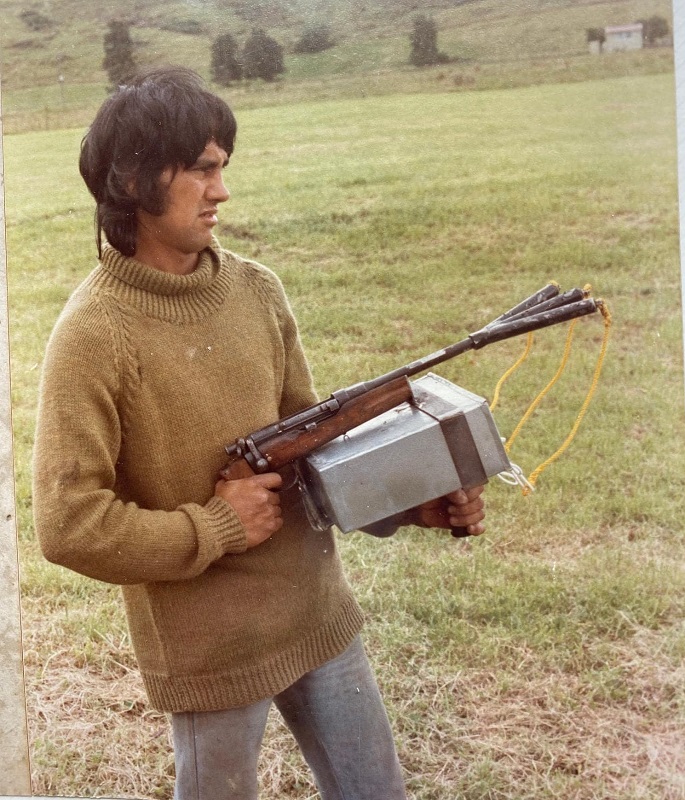James Cagney wrote some great posts about his father and net guns on FB. He has very kindly allowed me to collate them into a blog post.
One of the stories involved homemade rubber bullets and I thought it would be cool to share here.
Stories of the early days of the venison industry never cease to amaze me. All the talent and guts that went into getting it started, would make a great movie.
Here's an extract from the blog,
During the late 70's Robin Cagney started his early net gun development while he was with South West Helicopters. At the same time he experimented with other ideas for helicopter deer live capture, one of these was the use of rubber bullets to ‘stun’ deer.
Robin, always the gun guru and experimenter, found that one portion of the back end of a cowshed inflation rubber fitted perfectly in the bore of a 12 gauge shotgun. Robin made rubber 12 gauge slugs by cutting these to about 1 inch in length and plugging the hole in the middle with a rubber plug and adhesive.
He worked up loads in the 12 gauge, using the carcasses of dead bobby calves as the test media to perfect the right charge, so that he had the optimum velocity at the usual ‘out the helicopter door’ range to thump the deer, without breaking the skin. He worked the powder charge up until the rubber bullet would break the skin of the dead bobby calf and penetrate, and would then back the load off a grain, so that he had maximum thump, without penetrating and killing the animal.
When Robin and Patrick tested this out of the helicopter on deer, it knocked the deer down, but not for long. On an early experimental run, Patrick wanted to see the deer knocked down for a bit longer so there would be more time for Robin to jump on the incapacitated animal; he wanted Robin to increase the charge. Robin insisted that if he upped the charge it would kill the deer. A dead deer was worth only 5% to 10% the value of a live one at the time.
So they upped the powder charge - possibly by a couple more grains than required to prove the point. Anyways they got onto a big hind, Robin put the shot, from above, between the hinds shoulder blades. The rubber slug exited out the hinds brisket and rolled up dead.
Back to the drawing board - Robin figured that the only way to increase knock down thump without penetrating and killing the animal was to increase the diameter or the rubber bullet. His next ‘stun gun’ was built on a Lee Enfield .303 with the barrel cut down. The large diameter barrel was something like 1.5” - 1.75” in diameter, the perfect size for a push fit of the good old ‘superball’, the big solid rubber bouncy ball, a popular kids toy at the time.
The superball would be muzzle loaded with a ramrod and the .303 loaded with a blank net gun cartridge. This proved surprisingly accurate and effective in initial testing, but no doubt the potential ricochet hazard of that big bouncy ball caused some concerns. By this time the net gun had established itself as ‘the tool’ for helicopter live capture and it prevailed.
Welcome guest, is this your first visit? Create Account now to join.
Welcome to the NZ Hunting and Shooting Forums.
Search Forums
User Tag List
Results 1 to 6 of 6
 30Likes
30Likes
Thread: Rubber bullets and deer
Threaded View
-
22-04-2024, 04:13 PM #1
Rubber bullets and deer
Similar Threads
-
Rubber for ranger?
By The bomb in forum Outdoor TransportReplies: 44Last Post: 05-11-2022, 08:47 AM -
Rubber wipes in DPT suppressor
By Bill999 in forum Firearms, Optics and AccessoriesReplies: 26Last Post: 23-12-2018, 11:13 PM
Tags for this Thread
Welcome to NZ Hunting and Shooting Forums! We see you're new here, or arn't logged in. Create an account, and Login for full access including our FREE BUY and SELL section Register NOW!!





 LinkBack URL
LinkBack URL About LinkBacks
About LinkBacks





 Reply With Quote
Reply With Quote


Bookmarks